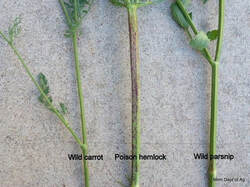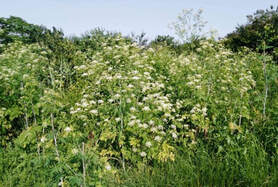
Poison Hemlock in Licking County
Poison hemlock is in full bloom throughout the county, and while pretty, is a very toxic plant
One of the most poisonous plants known to man has quietly spread throughout Licking County, as well as the rest of the state. You tend to see it alongside bike paths, near park edges and fields, and in dense colonies near the freeway. This pretty, yet toxic plant, is poison hemlock.
According to the USDA Agricultural Research Service, poison hemlock grows throughout the United States and is very toxic. Animals such a sheep, cattle, horses, and other domestic animals are poisoned by eating just a small amount. Poison hemlock is also extremely toxic to humans. Ingestion is "frequently fatal," due to highly toxic piperidine alkaloid compounds that cause respiratory failure, the USDA says.
What does Poison Hemlock look like?
The plant has a white root and a hollow stem with purple splotches
Hemlock poisoning symptoms can occur almost immediately after eating poison hemlock. These symptoms may include:
The best way to prevent hemlock poisoning, is to remove it all together. To get rid of poison hemlock, dig it out in small patches. ensuring to remove the roots. You can use herbicide on the plants in late fall or early spring, but not after their flowers have bloomed. Don’t cut, mow or burn poison hemlock — the seeds can re-sprout and the fumes can be toxic. Place the plants in plastic garbage bags and put them in the trash. Wear a face mask, long sleeves and gloves when handling poison hemlock. If you happen to find poison hemlock in or near your yard it is advised to properly remove it as soon as possible, especially if there are children around.
Licking County Health Department 675 Price Road Newark, Ohio 43055
Poison hemlock is in full bloom throughout the county, and while pretty, is a very toxic plant
One of the most poisonous plants known to man has quietly spread throughout Licking County, as well as the rest of the state. You tend to see it alongside bike paths, near park edges and fields, and in dense colonies near the freeway. This pretty, yet toxic plant, is poison hemlock.
According to the USDA Agricultural Research Service, poison hemlock grows throughout the United States and is very toxic. Animals such a sheep, cattle, horses, and other domestic animals are poisoned by eating just a small amount. Poison hemlock is also extremely toxic to humans. Ingestion is "frequently fatal," due to highly toxic piperidine alkaloid compounds that cause respiratory failure, the USDA says.
What does Poison Hemlock look like?
The plant has a white root and a hollow stem with purple splotches
- It can grow anywhere between 2 to 10 feet tall
- It has small, white flowers with petals that grow in an umbrella-shaped cluster
- Poison hemlock greatly resembles Queen Anne’s lace, wild parsnip, wild carrots and wild parsley
Hemlock poisoning symptoms can occur almost immediately after eating poison hemlock. These symptoms may include:
- Sweating
- Vomiting
- Dilated pupils
- Excess salivation
- Dry mouth
- Rapid heartbeat
- High blood pressure
- Restlessness or confusion
- Muscle weakness and muscle twitches
- Tremors and seizures
The best way to prevent hemlock poisoning, is to remove it all together. To get rid of poison hemlock, dig it out in small patches. ensuring to remove the roots. You can use herbicide on the plants in late fall or early spring, but not after their flowers have bloomed. Don’t cut, mow or burn poison hemlock — the seeds can re-sprout and the fumes can be toxic. Place the plants in plastic garbage bags and put them in the trash. Wear a face mask, long sleeves and gloves when handling poison hemlock. If you happen to find poison hemlock in or near your yard it is advised to properly remove it as soon as possible, especially if there are children around.
Licking County Health Department 675 Price Road Newark, Ohio 43055

